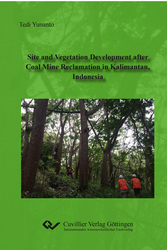| Departments | |
|---|---|
| Book Series (96) |
1378
|
| Nachhaltigkeit |
3
|
| Gesundheitswesen |
1
|
| Humanities |
2364
|
| Natural Sciences |
5406
|
| Mathematics | 229 |
| Informatics | 319 |
| Physics | 980 |
| Chemistry | 1363 |
| Geosciences | 131 |
| Human medicine | 243 |
| Stomatology | 10 |
| Veterinary medicine | 108 |
| Pharmacy | 147 |
| Biology | 835 |
| Biochemistry, molecular biology, gene technology | 121 |
| Biophysics | 25 |
| Domestic and nutritional science | 45 |
| Agricultural science | 1004 |
| Forest science | 201 |
| Horticultural science | 20 |
| Environmental research, ecology and landscape conservation | 148 |
| Engineering |
1793
|
| Common |
98
|
|
Leitlinien Unfallchirurgie
5. Auflage bestellen |
|
Advanced Search
Site and Vegetation Development after Coal Mine Reclamation in Kalimantan, Indonesia (English shop)
Tedi Yunanto (Author)Preview
Extract, PDF (1.3 MB)
Table of Contents, PDF (620 KB)
Coal is a rock composed of organic and inorganic materials, which contains 50% or more than 75% organic material (Fig. 1). The organic matter mostly consists of carbon ©, but is also comprised of hydrogen (H), oxygen (O), sulphur (S) and nitrogen (N). Besides organic matter, coal contains some inorganic compounds (minerals) and water (H2O). Naturally, coal is formed from vegetation that has been consolidated between other rock strata and altered by the combined effects of pressure and heat over millions of years to ultimately form coal seams (World Coal Institute, 2005).
| ISBN-13 (Hard Copy) | 9783736999411 |
| ISBN-13 (eBook) | 9783736989412 |
| Final Book Format | A5 |
| Language | English |
| Page Number | 272 |
| Edition | 1. |
| Publication Place | Göttingen |
| Place of Dissertation | Göttingen |
| Publication Date | 2018-12-28 |
| General Categorization | Dissertation |
| Departments |
Forest science
|
| Keywords | organic, coal, inorganic materials |








